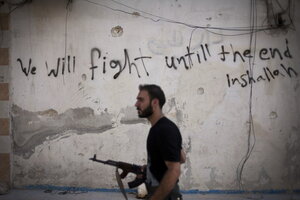Key to Syrian cease-fire: Sunni rebel groups
More than 60,000 of an estimated 80,000 Sunni fighters reportedly have signed on to the cease-fire. But rebel commanders say if their political goals are not met, they'll return to war.

A Free Syrian Army soldier walks through a street in Amariya district in Aleppo, Syria, on Sept. 10, 2012. After losing control of Aleppo, the rebels agreed to a cease-fire to begin at midnight on Dec. 29-30, 2016.
Manu Brabo/AP
Amman, Jordan
The groundbreaking cease-fire announced Thursday by the Syrian Army ostensibly has the crucial support of diverse Syrian rebel groups – as well as Russia, Turkey, and Iran.
But these diverse groups could prove to be the spoilers of the deal if their political goals are not met in upcoming talks in Astana, Kazakhstan.
“We do not only want an end to Assad, we want an end to the Assad regime,” Abu Mohammed, commander of a Free Syrian Army (FSA) unit north of Aleppo that has signed on to the deal, says via Skype.
“If the agreement in Astana puts us back at the mercy of a regime that has killed over 300,000 civilians and overrides the will of the Syrian people, we will return to the battlefield.”
By various estimates, there are 80,000 rebel fighters – 62,000 of whom will be covered by the cease-fire deal, according to Russian Defense Minister Sergei Shoigu.
For all their differences, the dozens of mainstream factions, sub-groups, and militias that have been fighting Syrian President Bashar al-Assad’s regime for five years share one overriding goal: the removal of Mr. Assad from power and the formation of a democratically elected government.
That necessarily implies more than a change in ruler, however.
By ousting Assad and committing to a government elected by a majority of the Syrian people, rebels – the vast majority of whom are Sunni – aim to change the sectarian balance of power in the country.
Governed for the past 40 years by the Assad family and members of their Alawite sect, Syria has been under the de facto rule of a Shiite minority, marginalizing Sunnis – who made up more than 70 percent of Syria’s pre-war population.
The cease-fire agreement reportedly will pave the way for Assad to step down from power – though potentially not until the next presidential election – but it does not call for an end to Alawite rule. Some reports say Assad would likely be replaced with an official from his inner circle with less blood on his hands.
In fact, some rebel commanders believe that continued Alawite rule is a condition of Iran, whose troops and allied Shiite militias have propped up Assad for much of the past four years.
Although optimistic about the cease-fire, Sunni commanders remain concerned that retaliation from the various Shiite militias allied with the Assad regime – such as Hezbollah and Iraqi fighters, which are not mentioned by name in the cease-fire agreement and act with relative impunity – will doom the deal.
“If Shiite militias move against us or civilians, Syrian revolutionaries will strike back and the cease-fire will be dead,” says Abdul Hadi Sari, a former air force general and rebel commander currently residing in Jordan, interviewed via phone.
More than 60 rebel factions
Another challenge for the cease-fire to hold is the sheer number of competing rebel militias, factions, and subgroups.
There are 54 factions in the FSA-aligned southern front. In the north and west, there are more than 60. In addition, there are currently several factions aligned with Turkey in its efforts to push back Kurdish militias and ISIS in the north.
Opposition leaders and FSA commanders have described various brigades as “personal mafias,” controlled by commanders who pocket as much as 30 percent of the funds they receive from Saudi Arabia, Qatar, and Turkey for arms purchases.
The personal incentive to receive direct funds and arms from the rebels’ various backers has prevented moderate rebel brigades from uniting in a wider front.
These divisions led to the rebels’ collapse and pushed the Syrian opposition to the negotiating table with Russia in Ankara, Turkey. But it is also this very fragmentation – and the money and power at stake – that casts doubt over the over 100-plus militias’ ability – and willingness – to abide by the cease-fire terms.
Al Qaeda affiliate
The largest question mark looming over the cease-fire is Al Qaeda’s affiliate in Syria, Jabhat Fateh al Sham, often still referred to by its previous name, Jabhat al Nusra.
Syrian rebels claim that Nusra has been included in the cease-fire deal, while the Syrian Army and Russian state media insists that it has not.
Nusra includes only 5,000 to 10,000 fighters, according to various estimates – a fraction of the 80,000 fighters in various militias. However, it remains the best-armed, best-trained, and most effective rebel force on the Syrian battlefield.
Nusra has become so intertwined with mainstream rebel groups, working in joint offenses with the Islamist movement Ahrar as Sham and the FSA in the south along the Golan Heights, in Aleppo, and now Idlib, that FSA commanders and fighters have referred to the group as “our last best chance to overthrow the regime.”
Such close cooperation will make it difficult for Russia and Turkey to isolate the group – and it may be used by the Syrian regime as an excuse to continue its campaign against rebels, putting any peace deal at risk.
Nusra has not yet officially responded to the cease-fire deal. But members vow they will carry on the fight as “part of the Syrian society.”
“There is no cease-fire and no peace deal while there is injustice and massacres,” says Abu Baker, an Al Nusra operative in the south, via an encrypted messaging app. “Under these conditions, Jabhat Fateh as Sham will carry on the revolution.”

